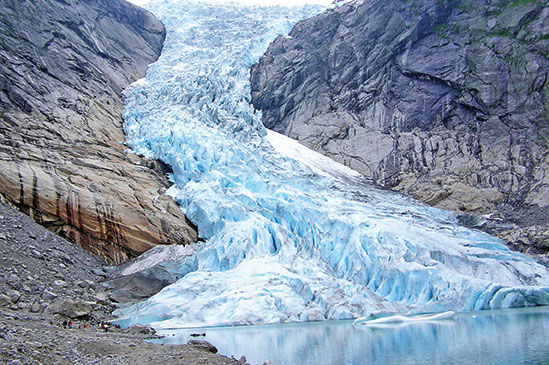 Social Sciences
Social Sciences
Icebreaker

Lincoln James likes slippery slopes. That’s slippery as in ice.
James is a junior environmental studies major who spent a good part of his second year at the UO exercising a newfound curiosity about glaciers. He’s turning it into a research project that probes the origins of glaciology—the study of ice as it occurs in the world around us, including seasonal snow, sea ice, and, of course, glaciers.
James wants to know how glaciology came to be a science, and especially whether the early European climbers who ventured onto mysterious, ice-jacketed mountains were the ones who put glaciology on the scientific map. But rather than strapping spikes to his boots and grabbing an ice axe, James made a bold ascent of the Knight Library stacks, looking for copies of expedition journals and early accounts in both scientific journals and the popular press.
His hunch was right: the same people who summited those peaks were the first ones to study the ice shrouding them. Starting in the early 18th century and continuing through the next one, James learned the early mountaineers of the modern climbing era took the first measurements of glacial ice, its movement, and the high-altitude weather, collecting data that formed the foundation of what would become glaciology.
 “There was this element of exploration and wanting to be the first to get to the top of these peaks and say they did it, but there was also a lot of research they wanted to do while they were up there,” James (left) said. “After peaks had been conquered, the focus changed to the glaciers and how they had shaped the environment.”
“There was this element of exploration and wanting to be the first to get to the top of these peaks and say they did it, but there was also a lot of research they wanted to do while they were up there,” James (left) said. “After peaks had been conquered, the focus changed to the glaciers and how they had shaped the environment.”
It took those early explorers some time to develop a theory for the formation of glaciers that stood up to the data that they were collecting. But they eventually came up with a premise that closely tracks what’s known today—namely, that glaciers are moving rivers of compressed ice formed through eons of snowfall. James found that from the early 1700s through the end of the 1800s, the scientists interested in glaciers gradually split off from the explorers, realizing that they didn’t have to reach the summit to study ice that extends thousands of feet below.
“The way that people understood glaciers changed completely over that period of time,” he said.
Glaciers are a new interest for James, one that blossomed from a serendipitous encounter with a UO researcher with his own fascination for those eerily blue, slow-moving rivers of ice. Mark Carey, an associate professor of history in the Clark Honors College, has long studied the way glaciers affect people, communities, and ways of life.
Carey runs a website called Glaciers, Climate, and Society that collects global information and resources on glacial hazards, climate change, and water. Of particular interest is the danger indigenous people face from avalanches and floods set off by melting ice that, once gone, will also close the spigot on a main source of drinking and irrigation water.
James is doing his research as part of a major National Science Foundation grant that Carey received to study how glaciers affect people and society. As James sifts through the history books, he is building the beginnings of a future honors thesis while gaining a valuable research experience.
The young researcher is undaunted by the pace of discovery, which might best be described as, well, glacial.
“I’ve learned that research can be a frustrating and slow process, but also a very rewarding one,” he said. “I can’t imagine a better way to learn.”
—By Greg Bolt


 Twitter
Twitter Facebook
Facebook Forward
Forward